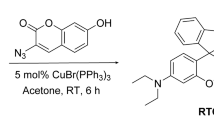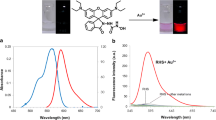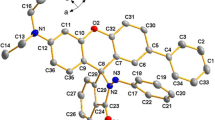Abstract
A novel fluoro-chromogenic rhodamine spirolactam probe (RP) has been prepared through the condensation of rhodamine hydrazine and 2-acetylpyridine, which displayed the detection of Cu2+ with high selectivity over a large number of other common metal ions. It shows a “turn-on” response to paramagnetic Cu2+ with an about 12-fold enhancement, and a color change from colorless to red that is observable by the naked eye. These changes are ascribed to the ring-opening of the spirolactam in RP, and subsequent host–guest coordination. The 2:1 binding stoichiometry of RP to Cu2+ was confirmed by Job’s and B-H plots. The resulting fluorescence enhancement can be used to detect Cu2+ at concentrations from 2.0 to 20.0 μM with a limit of detection of 0.21 μM, which was lower than the maximum allowable Cu2+ level set by the WHO. Finally, RP has been utilized to monitor Cu2+ in living cells and natural water.

Graphical abstract









Similar content being viewed by others
References
Mathie A, Sutton LG, Clarke EC, Veale E. Zinc and copper: pharmacological probes and endogenous modulators of neuronal excitability. Pharmacol Ther. 2006;111:567–83.
Uauy R, Olivares M, Gonzalez M. Essentiality of copper in humans. Am J Clin Nutr. 1998;67(5):952–9.
Jiawei L, Fangjun H, Caixia Y. Cu2+ biological imaging probes based on different sensing mechanisms. Curr Med Chem. 2017;24:1–44.
Huo J, Liu K, Zhao X, Zhang X, Wang Y. Simple and sensitive colorimetric sensors for the selective detection of Cu2+ in aqueous buffer. Spectrochim Acta A. 2014;117:789–92.
Mayr T, Klimant I, Wolfbeis OS, Werner T. Dual lifetime referenced optical sensor membrane for the determination of copper (II) ions. Anal Chim Acta. 2002;462(1):1–10.
Tang L, Dai X, Wen X, Wu D, Zhang Q. A rhodamine-benzothiazole conjugated sensor for colorimetric, ratiometric and sequential recognition of copper (II) and sulfide in aqueous media. Spectrochim Acta A. 2015;139:329–34.
Zhang Y, Zeng X, Mu L, Chen Y, Zhang J-X, Redshaw C, et al. Rhodamine-triazine based probes for Cu2+ in aqueous media and living cells. Sensors Actuators B Chem. 2014;204:24–30.
Xu J, Hou Y, Ma Q, Wu X, Feng S, Zhang J, et al. A highly selective fluorescent probe for Cu2+ based on rhodamine B derivative. Spectrochim Acta A. 2014;124:416–22.
Gao W, Yang Y, Huo F, Yin C, Xu M, Zhang Y, et al. An ICT colorimetric chemosensor and a non-ICT fluorescent chemosensor for the detection copper ion. Sensors Actuators B Chem. 2014;193:294–300.
Yang Y, Huo F, Yin C, Chu Y, Chao J, Zhang Y, et al. Combined spectral experiment and theoretical calculation to study the chemosensors of copper and their applications in anion bioimaging. Sensors Actuators B Chem. 2013;177:1189–97.
Puangploy P, Smanmoo S, Surareungchai W. A new rhodamine derivative-based chemosensor for highly selective and sensitive determination of Cu2+. Sensors Actuators B Chem. 2014;193:679–86.
Dai K, Xu B, Chen J. A rhodamine-based “off-on” colorimetric and fluorescent chemosensor for Cu (II) in aqueous and non-aqueous media. J Fluoresc. 2014;24(4):1129–36.
Tang L, Zhou P, Zhong K, Hou S. Fluorescence relay enhancement sequential recognition of Cu2+ and CN− by a new quinazoline derivative. Sensors Actuators B Chem. 2013;182:439–45.
Aksuner N, Henden E, Yilmaz I, Cukurovali A. A highly sensitive and selective fluorescent sensor for the determination of copper (II) based on a Schiff base. Dyes Pigments. 2009;83(2):211–7.
Liu L, Dong X, Xiao Y, Lian W, Liu Z. Two-photon excited fluorescent chemosensor for homogeneous determination of copper (ii) in aqueous media and complicated biological matrix. Analyst. 2011;136(10):2139–45.
Sikdar A, Roy S, Haldar K, Sarkar S, Panja SS. Rhodamine-based Cu2+-selective fluorosensor: synthesis, mechanism, and application in living cells. J Fluoresc. 2013;23(3):495–501.
Kumar M, Kumar N, Bhalla V, Sharma PR, Kaur T. Highly selective fluorescence turn-on chemodosimeter based on rhodamine for nanomolar detection of copper ions. Org Lett. 2012;14(1):406–9.
Hu J, Hu Z, Chen Z, Gao H-W, Uvdal K. A logic gate-based fluorogenic probe for Hg2+ detection and its applications in cellular imaging. Anal Chim Acta. 2016;919:85–93.
Tang J-L, Li C-Y, Li Y-F, Lu X, Qi H-R. A highly sensitive and selective fluorescent probe for trivalent aluminum ion based on rhodamine derivative in living cells. Anal Chim Acta. 2015;888:155–61.
Adhikari S, Ghosh A, Sahana A, Guria S, Das D. Tailoring ligand environment toward development of colorimetric and fluorescence indicator for biological Mn (II) imaging. Anal Chem. 2016;88(2):1106–10.
Yang X-F, Guo X-Q, Zhao Y-B. Development of a novel rhodamine-type fluorescent probe to determine peroxynitrite. Talanta. 2002;57(5):883–90.
Ozdemir M. A rhodamine-based colorimetric and fluorescent probe for dual sensing of Cu2+ and Hg2+ ions. J Photochem Photobiol A. 2016;318:7–13.
Liu K, Guo P, Liu L, Shi X. Fluorescence enhancement of a novel pyrazine coupled rhodamine derivative for the paramagnetic Co2+ detection. Sensors Actuators B Chem. 2017;250:667–72.
Chereddy NR, Suman K, Korrapati PS, Thennarasu S, Mandal AB. Design and synthesis of rhodamine based chemosensors for the detection of Fe3+ ions. Dyes Pigments. 2012;95(3):606–13.
Liu K, Zhang Y, Zhou T, Liu X, Chen B, Wang X, et al. Sequential recognition of Hg2+ and I− based on a novel BODIPY-salen sensor. Sensors Actuators B Chem. 2017;253:1194–8.
Liu Y, Fei Q, Shan H, Cui M, Liu Q, Feng G, et al. A novel fluorescent 'off-on-off' probe for relay recognition of Zn2+ and Cu2+ derived from N,N-bis(2-pyridylmethyl)amine. Analyst. 2014;139(8):1868–75.
Goswami S, Chakraborty S, Paul S, Halder S, Panja S, Mukhopadhyay SK. A new pyrene based highly sensitive fluorescence probe for copper (ii) and fluoride with living cell application. Org Biomol Chem. 2014;12(19):3037–44.
Chatterjee N, Mahaling B, Sivakumar S, Bharadwaj PK. A highly selective and sensitive “turn-on” fluorescence chemosensor for the Cu2+ ion in aqueous ethanolic medium and its application in live cell imaging. J Photochem Photobiol A. 2016;330:110–6.
Yang X, Zhang W, Yi Z, Xu H, Wei J, Hao L. Highly sensitive and selective fluorescent sensor for copper (ii) based on salicylaldehyde Schiff-base derivatives with aggregation induced emission and mechanoluminescence. New J Chem. 2017;41(19):11079–88.
Liu H, Wu F, Zhang B, Tan C, Chen Y, Hao G, et al. A simple quinoline-derived fluorescent sensor for the selective and sequential detection of copper(ii) and sulfide ions and its application in living-cell imaging. RSC Adv. 2016;6(81):77508–14.
Li Y, Han X, Song Y. An azo-phenol derivative probe: colorimetric and “turn-on” fluorescent detection of copper(ii) ions and pH value in aqueous solution. RSC Adv. 2017;7(33):20537–41.
You Q-H, Lee AW-M, Chan W-H, Zhu X-M, Leung KC-F. A coumarin-based fluorescent probe for recognition of Cu2+ and fast detection of histidine in hard-to-transfect cells by a sensing ensemble approach. Chem Commun. 2014;50(47):6207–10.
Mandal AK, Suresh M, Das P, Suresh E, Baidya M, Ghosh SK, et al. Recognition of Hg2+ ion through restricted imine isomerization: crystallographic evidence and imaging in live cells. Org Lett. 2012;14(12):2980–3.
Guo B, Nie H, Yang W, Tian Y, Jing J, Zhang X. A highly sensitive and rapidly responding fluorescent probe with a large stokes shift for imaging intracellular hypochlorite. Sensors Actuators B Chem. 2016;236:459–65.
Acknowledgments
We thank Meisi Sheng and Hongchun Dong for their collection of natural water and the detection of Cu2+ in sample.
Funding
This research was supported by Foundation of Tianjin Normal University (No. 53H14040 and No. WLQR201809), National Natural Science Foundation of China (No. 21572160), and the Program for Innovative Research Team in University of Tianjin (TD13-5074).
Author information
Authors and Affiliations
Corresponding authors
Ethics declarations
Conflict of interest
The authors declare that they have no conflicts of interest.
Additional information
Publisher’s note
Springer Nature remains neutral with regard to jurisdictional claims in published maps and institutional affiliations.
Electronic supplementary material
ESM 1
(PDF 384 kb)
Rights and permissions
About this article
Cite this article
Liu, K., Xu, S., Guo, P. et al. A novel fluoro-chromogenic Cu2+ probe for living-cell imaging based on rhodamine 6G-pyridine conjugation. Anal Bioanal Chem 411, 3021–3028 (2019). https://doi.org/10.1007/s00216-019-01748-8
Received:
Revised:
Accepted:
Published:
Issue Date:
DOI: https://doi.org/10.1007/s00216-019-01748-8




